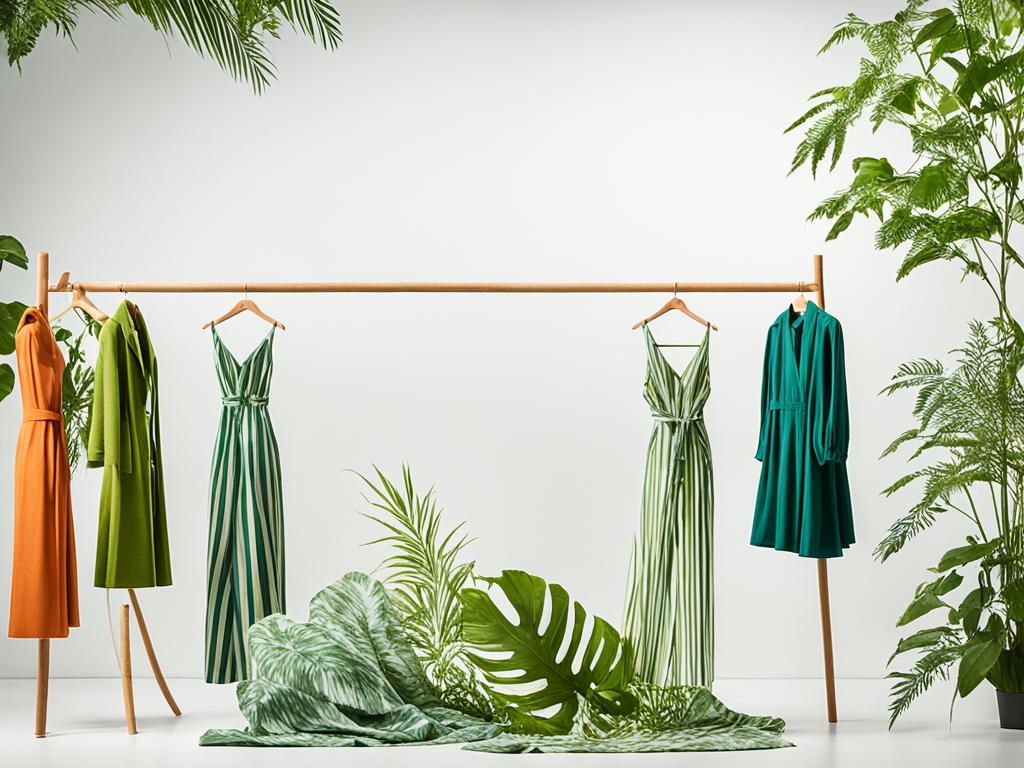Welcome to the world of eco-friendly fashion, where sustainability and style go hand in hand. Embracing sustainability in your wardrobe choices is not just a trend but a responsible way to contribute to a greener future. In this article, we will explore the latest trends and innovations that are transforming the fashion industry, allowing you to build a sustainable wardrobe without compromising on style.
Key Takeaways:
- Eco-friendly fashion combines sustainability and style.
- Building a sustainable wardrobe is a responsible choice for a greener future.
- Stay tuned to discover the latest trends and innovations in eco-friendly fashion.
- Create a wardrobe that aligns with your values without compromising on style.
- Make conscious choices and support ethical brands to contribute to a more sustainable fashion industry.
The Future of Fashion: Embracing Sustainability
In recent years, the fashion industry has experienced a transformative shift towards sustainability. As concerns about the environmental and social impacts of fashion continue to grow, both consumers and brands are recognizing the urgent need for change. Embracing sustainability is no longer just a trend; it is the future of fashion.
By embracing sustainability, the fashion industry can address critical issues such as pollution, waste, and unethical working conditions. Adopting sustainable practices not only benefits the planet but also promotes a more equitable and conscious fashion ecosystem.
One of the key drivers for change is increasing consumer awareness and demand for eco-friendly and socially responsible fashion. People around the world are becoming more conscious of their consumption habits and are actively seeking out brands that align with their values. As a result, fashion brands are adapting their strategies and incorporating sustainability into their core business models.
“The future of fashion lies in sustainability. It is no longer acceptable for brands to prioritize profit over ethical and environmental considerations. Consumers are demanding change, and brands must rise to the challenge.”
The future of fashion is ingrained in sustainability, and this mindset shift is evident in several aspects of the industry. From design and production to supply chain management and consumer behavior, sustainability is permeating every level.
Brands are exploring innovative materials and manufacturing processes that minimize environmental impact. Sustainable fabrics made from organic or recycled materials, such as eco-friendly cotton, bamboo, and TENCEL™, are increasingly being used in collections. Moreover, fashion companies are implementing circular economy models by embracing concepts like upcycling and recycling to reduce waste and extend the lifespan of garments.
Transitioning to a sustainable fashion industry also involves promoting transparency and ethical labor practices. Take, for example, the increasing demand for fair trade and ethically produced clothing. Consumers want to know that the people involved in the production process are treated fairly and that their purchases support responsible manufacturing practices.
The future of fashion is about fostering a culture of mindfulness and accountability. Brands and consumers alike have the power to drive change by making conscious choices and embracing sustainable fashion practices. As we move forward, it is crucial for the industry to continue innovating and collaborating to build a more sustainable and ethical fashion ecosystem.
In the next section, we will explore practical tips and tricks to help you shop sustainably, allowing you to contribute to the future of fashion while building a sustainable wardrobe that reflects your values.
How to Shop Sustainably: Tips and Tricks
When it comes to building a sustainable wardrobe, shopping consciously is key. By making informed choices and supporting ethical brands, you can reduce your environmental impact and contribute to a more sustainable fashion industry. Here are some practical tips and tricks to help you shop sustainably:
1. Research Ethical Brands
One of the most effective ways to shop sustainably is by buying from ethical brands. These brands prioritize fair trade practices, use eco-friendly materials, and ensure safe and ethical working conditions. Take the time to research and discover brands that align with your values. Look for certifications such as Fair Trade Certified, Global Organic Textile Standard (GOTS), or the Certified B Corporation seal. These certifications indicate that the brand meets specific sustainability and ethical criteria.
2. Choose Quality over Quantity
Instead of buying numerous cheap and low-quality items, focus on investing in high-quality pieces that will stand the test of time. Opt for durable fabrics and timeless designs that can be worn season after season. By choosing quality over quantity, you not only reduce the amount of waste generated but also save money in the long run.
3. Embrace Secondhand Shopping
Shopping secondhand is a fantastic way to reduce waste and give pre-loved items a new lease on life. Explore thrift stores, consignment shops, and online platforms dedicated to secondhand fashion. You’ll be surprised at the hidden gems you can find while also saving money. Additionally, consider organizing clothing swaps with friends or joining local swap events to refresh your wardrobe without spending a dime.
4. Understand Labels and Certifications
Labels and certifications can provide valuable information about a product’s sustainability credentials. Familiarize yourself with common certifications and what they mean. Look for labels such as organic, recycled, cruelty-free, and vegan, among others. These labels indicate that the product meets specific sustainability standards and aligns with your values.
5. Practice Mindful Shopping
Before making a purchase, ask yourself if you truly need the item and if it aligns with your personal style. Avoid impulse buys and fast fashion trends that come and go quickly. By practicing mindful shopping, you can avoid unnecessary purchases and focus on building a wardrobe that reflects your values and personal taste.
“The power of the consumer is immense. Every time you shop, you’re casting a vote for the kind of world you want to live in.”
– Emma Watson
By implementing these tips and tricks, you can embrace sustainable shopping practices and create a wardrobe that not only looks great but also supports the planet and its people. Remember, small changes can make a big difference in the fashion industry.
Ethical Brands: Leading the Change in the Industry
In the ever-evolving fashion industry, ethical brands are playing a pivotal role in leading the change towards a more sustainable and responsible future. These innovative companies prioritize sustainability, ethical manufacturing practices, and fair trade principles, making it easier for you to support brands that align with your values. Let’s explore some of the ethical fashion brands that are making a positive impact in the industry.
1. Patagonia
At the forefront of the sustainable fashion movement, Patagonia has long been recognized for its commitment to environmental and social responsibility. The outdoor clothing company is dedicated to using eco-friendly materials, reducing waste, and promoting fair labor practices. With a strong emphasis on transparency, Patagonia encourages customers to repair their products rather than purchasing new ones, further reducing their environmental footprint.
2. Everlane
Everlane is renowned for its “radical transparency” in the fashion industry. The brand provides detailed information about its manufacturing process, from the factories used to the cost breakdown of each product. By partnering with ethical factories and sourcing high-quality materials, Everlane creates timeless and sustainable clothing. Through their “Choose What You Pay” program, they promote fair pricing and offer customers the option to pay what they believe is right for the product.
3. Reformation
Reformation is a brand that combines style, sustainability, and inclusivity. Known for its chic designs, Reformation uses eco-friendly materials and practices sustainable manufacturing processes. The brand also focuses on size-inclusivity, offering a wide range of sizes to cater to different body types. Through their RefScale, Reformation tracks the environmental impact of each garment, providing transparency and accountability.
4. People Tree
People Tree is a pioneer in the fair trade fashion movement, working with artisans and farmers around the world to create sustainable and ethical clothing. The brand takes a holistic approach to sustainability, considering the entire supply chain from organic farming to safe working conditions. People Tree’s commitment to transparency and fair wages ensures that every product is made with care for both people and the planet.
These are just a few examples of ethical brands that are leading the change in the fashion industry. By supporting these companies, you can be part of the movement towards a more sustainable and responsible fashion ecosystem. Embracing ethical brands not only allows you to make conscious fashion choices but also contributes to a positive impact on the industry as a whole.
The Role of Recycling and Upcycling in Fashion
The fashion industry is increasingly embracing sustainable practices, and recycling and upcycling play a vital role in this transformation. These processes not only help reduce waste but also promote circular fashion, turning unwanted items into stylish and unique pieces.
Recycling in fashion involves the conversion of used garments and textiles into new materials. Through recycling, fabric waste can be minimized, and valuable resources can be conserved. This process often involves breaking down textiles, extracting fibers, and re-spinning them into new yarns. By incorporating recycled fibers into new clothing or accessories, designers can reduce the reliance on virgin materials and contribute to a more sustainable fashion ecosystem.
Upcycling takes sustainability a step further by transforming pre-loved or discarded items into new, fashionable pieces. It involves repurposing existing materials and giving them a new lease on life. From repurposing vintage clothing to creating accessories from scrap fabrics, upcycling allows designers and consumers to unleash their creativity while reducing waste.
One notable example of upcycling in fashion is the use of denim. Instead of discarding old jeans, they can be transformed into trendy denim jackets, bags, and even footwear. By giving these items a second chance, we can extend their lifespan and divert them from landfills.
Benefits of Recycling and Upcycling
Recycling and upcycling in fashion offer several benefits:
- Environmental Impact: By reducing fabric waste and the extraction of new resources, recycling and upcycling help conserve energy, water, and natural materials. These practices contribute to a more sustainable and responsible fashion industry.
- Circular Fashion: Recycling and upcycling support the transition towards a circular fashion economy, where resources are continuously used and repurposed, reducing the need for new production and minimizing waste.
- Creativity and Uniqueness: Upcycling allows for the creation of one-of-a-kind fashion pieces. By repurposing existing materials, designers can showcase their creativity and offer consumers unique garments and accessories that stand out from mass-produced fashion items.
- Social Impact: Recycling and upcycling initiatives often involve collaborations with local communities, providing employment opportunities and contributing to sustainable livelihoods. By supporting upcycled fashion brands, you can contribute to positive social change.
By embracing recycling and upcycling in fashion, we can move towards a more sustainable future, where waste is minimized, resources are conserved, and creativity thrives. Whether you’re a designer, a consumer, or a fashion enthusiast, consider incorporating recycled and upcycled fashion items into your wardrobe to make a positive impact on the environment and support the circular fashion movement.
Sustainable Fabrics: Choosing Eco-Friendly Materials
When it comes to building a sustainable wardrobe, one of the key considerations is the choice of fabrics and materials. The fashion industry is increasingly embracing sustainable practices, and there is a wide range of eco-friendly options available that minimize harm to the planet. Understanding the environmental impact of different textiles can help you make informed decisions and contribute to a more sustainable future.
Organic cotton is one such sustainable fabric that has gained popularity in recent years. It is grown without the use of harmful pesticides and chemicals, making it better for both the environment and the farmers who cultivate it. Organic cotton garments are not only soft and comfortable to wear but also have a significantly lower carbon footprint compared to conventionally grown cotton.
Recycled polyester is another eco-friendly material making waves in the fashion industry. It is created by converting post-consumer plastic bottles into fibers that can be woven into textiles. Choosing clothing made from recycled polyester reduces the demand for new raw materials and helps to divert plastic waste from landfills and oceans.
A Comparison of Sustainable Fabrics
| Fabric | Environmental Impact | Advantages |
|---|---|---|
| Organic Cotton | – Less water and energy consumption – No chemical pesticides – Lower carbon footprint |
– Soft and comfortable to wear – Supports fair trade and ethical practices |
| Recycled Polyester | – Reduces plastic waste – Lowers carbon emissions – Decreases reliance on virgin materials |
– Durable and wrinkle-resistant – Provides moisture-wicking properties |
| Linen | – Requires fewer pesticides and water – Biodegradable and recyclable |
– Breathable and lightweight – Naturally hypoallergenic |
| Tencel | – Made from sustainably harvested wood pulp – Highly renewable and biodegradable |
– Silky smooth and gentle on the skin – Absorbs moisture efficiently |
In addition to organic cotton and recycled polyester, there are other sustainable fabrics worth considering. Linen, for example, is a natural fiber made from the flax plant. It requires fewer pesticides and less water to grow, making it a highly sustainable choice. Linen garments are known for their breathability and lightweight feel, perfect for warm climates.
Tencel, also known as lyocell, is another innovative sustainable fabric. It is derived from sustainably harvested wood pulp, typically from eucalyptus trees. Tencel is known for its softness, durability, and ability to absorb and release moisture efficiently, making it a versatile choice for various clothing items.
By choosing sustainable fabrics like organic cotton, recycled polyester, linen, and Tencel, you are making a conscious effort to reduce your environmental impact. These materials not only offer unique benefits in terms of comfort and durability but also contribute to a more sustainable fashion industry in the long run.
Eco-Friendly Fashion: Styling Tips for a Sustainable Wardrobe
Creating a fashionable and sustainable wardrobe doesn’t mean compromising on style. With these styling tips, you can embrace eco-friendly fashion and make a positive impact on the planet.
1. Mix and match eco-friendly pieces:
Create versatile outfits by mixing and matching your eco-friendly fashion items. Pair a sustainably-made blouse with jeans or a skirt, or layer a statement jacket over a simple dress. By maximizing the versatility of your pieces, you can create a wide range of stylish looks while reducing the need to constantly buy new clothes.
2. Create a capsule wardrobe:
Building a capsule wardrobe is an excellent way to curate a sustainable collection of clothes. Start by selecting core pieces that can be mixed and matched easily. Choose timeless, high-quality items that you love and feel confident in. By investing in quality essentials, you’ll create a wardrobe that lasts, reducing the need for constant shopping and promoting a more sustainable lifestyle.
3. Opt for versatile accessories:
Accessories can transform an outfit and add a personal touch to your style. When choosing accessories, opt for versatile pieces made from sustainable materials, such as bamboo sunglasses, recycled metal jewelry, or upcycled handbags. These eco-friendly accessories will elevate your outfits while aligning with your commitment to a sustainable wardrobe.
Remember, eco-friendly fashion is about making thoughtful choices that prioritize the planet and people. By embracing sustainable styling tips, you can create a wardrobe that reflects your values without compromising on style.
4. Embrace upcycling:
Upcycling is a creative way to give new life to old clothing items and reduce waste. Instead of discarding worn-out or ill-fitting clothes, consider upcycling them into something new. For example, turn an old t-shirt into a trendy tote bag or repurpose denim jeans into a stylish skirt. Upcycling not only reduces the demand for new clothing but also allows you to express your unique style.
| Styling Tip | Description |
|---|---|
| Mix and match | Create versatile outfits by mixing and matching eco-friendly pieces in your wardrobe. |
| Create a capsule wardrobe | Build a sustainable collection of essential pieces that can be mixed and matched easily. |
| Opt for versatile accessories | Choose eco-friendly accessories made from sustainable materials to complement your outfits. |
| Embrace upcycling | Transform old or worn-out clothing items into something new and stylish. |
By following these styling tips, you can embrace eco-friendly fashion and create a sustainable wardrobe that reflects your personal style. Remember, every small step towards sustainability makes a difference, and your fashion choices can contribute to a better future for the planet.
Conclusion
Throughout this article, we have explored the world of eco-friendly fashion and its role in creating a sustainable wardrobe. By embracing eco-friendly fashion, you can make a positive impact on the environment and contribute to a more sustainable and stylish fashion industry.
One of the key takeaways from this discussion is the importance of making conscious choices when it comes to shopping. By supporting ethical brands that prioritize sustainability and fair trade principles, you can ensure that your wardrobe aligns with your values.
Additionally, understanding the role of recycling, upcycling, and sustainable fabrics in fashion can help you make more informed decisions. By opting for recycled materials and eco-friendly textiles, you can reduce waste and minimize the environmental impact of your clothing choices.
Ultimately, building a sustainable wardrobe is not about giving up style, but rather finding fashionable and conscious alternatives. By following the tips and tricks mentioned in this article, such as creating capsule wardrobes and styling eco-friendly pieces, you can create stylish outfits while still being mindful of the environment.







